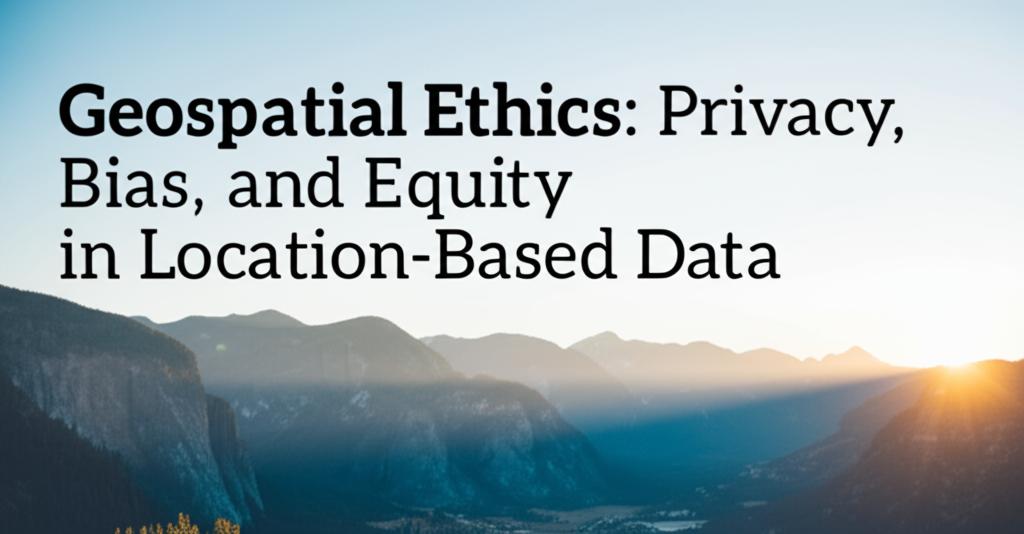Location-based data is increasingly woven into the fabric of our daily lives, powering everything from navigation apps to targeted advertising and urban planning. However, its proliferation raises critical ethical questions concerning privacy, bias, and equity. As geospatial technology and artificial intelligence (GeoAI) continue to evolve, it's essential to address these challenges to ensure responsible and fair use.
Privacy in an Era of Pervasive TrackingOne of the most significant concerns with location data is the potential for privacy invasion. Smartphones and countless other devices constantly collect our location, often with vague user consent that doesn't fully explain how this data is used or shared. This data can reveal sensitive information about individuals' habits, preferences, home addresses, workplaces, and even visits to medical facilities.
The risk of unauthorized access or data breaches is substantial, and the consequences can be severe, potentially leading to identity theft or reputational harm. Even anonymized or aggregated location data can sometimes be de-anonymized or inadvertently reveal information about individuals or groups, especially when combined with other datasets.
To mitigate these risks, robust security measures and privacy-preserving techniques are crucial. These include methods like geo-indistinguishability, which adds noise to location data to protect individual points while still allowing for analysis. Other approaches focus on minimizing data collection, ensuring data is only used for its intended purpose (purpose limitation), and providing users with clear opt-out mechanisms and control over their data.
Bias in Geospatial Data and AIGeospatial data and the AI algorithms that analyze it are not inherently objective. They can reflect and even amplify existing societal biases. This can occur in several ways:
- Data Collection Bias: Datasets may underrepresent certain demographics or geographic areas. For example, data collected from smartphones might miss populations with limited access to technology, such as children, the elderly, or those experiencing homelessness or poverty. This can lead to skewed analyses and inequitable resource allocation.
- Algorithmic Bias: AI models trained on biased data can perpetuate and even worsen these biases. For instance, biased mapping data could lead to inaccurate identification of areas in need, impacting emergency response or the distribution of public services. Similarly, AI used in autonomous vehicles trained on unrepresentative data could lead to unsafe outcomes for certain groups.
- Historical Bias: Using historical data that reflects past discriminatory practices (e.g., redlining in housing) can lead to AI systems that continue these patterns of inequality.
Addressing bias requires a multi-pronged approach. This includes auditing datasets for fair representation, using diverse data sources, and incorporating community input to ensure accuracy and fairness. Bias detection tools and techniques like rebalancing datasets or using fair representation learning algorithms during AI model training can help mitigate these issues. A "human-in-the-loop" approach, where humans review and validate AI decisions, is also important for ensuring fairness and accountability.
Equity and Fair Access to BenefitsGeospatial technologies have the power to drive progress and address societal challenges, from disaster relief and environmental conservation to urban planning and public health. However, if these tools and the insights they generate are not accessible to all, they can exacerbate existing disparities.
Ensuring equitable access means more than just making data and tools available. It involves designing inclusive solutions and addressing systemic barriers that prevent marginalized communities from benefiting from geospatial advancements. This includes democratizing access to GIS tools through open-source platforms and user-friendly interfaces, making it easier for non-experts to leverage location-based data.
Furthermore, a social justice lens should be applied to spatial analytics to identify and understand inequities, support informed and equitable decision-making, and empower underserved communities. This involves actively collaborating with the communities being studied and ensuring their voices are heard in the development and deployment of geospatial solutions.
The Path Forward: Governance, Transparency, and AccountabilityAs geospatial technology becomes more powerful and pervasive, the need for strong ethical frameworks and governance is paramount. This involves:
- Clear Guidelines and Regulations: Policymakers and legislators must collaborate with geospatial experts to establish comprehensive ethical guidelines and spatial laws covering privacy, safety, bias, and data ownership.
- Transparency and Explainability: AI systems, particularly "black box" algorithms, need to be more transparent and explainable so users can understand how decisions are made. This is essential for building trust and identifying errors or biases.
- Accountability: Establishing clear lines of responsibility for the misuse of geospatial data is crucial, especially when data is shared across multiple organizations.
- Ethical Purpose: Organizations must critically evaluate their objectives and ensure that their use of geospatial data aligns with positive, socially beneficial outcomes, rather than exploitative or discriminatory practices.
- Education and Awareness: Raising public awareness about geospatial technologies, their potential benefits, and ethical considerations is vital. Integrating geospatial education and ethics into curricula can cultivate a new generation of responsible users and developers.
The journey towards ethical geospatial practices is ongoing. It requires a commitment to continuous evaluation, adaptation to new technological developments, and a collaborative effort involving researchers, industry, policymakers, and the public to ensure that location-based data is used responsibly, equitably, and for the betterment of society.

